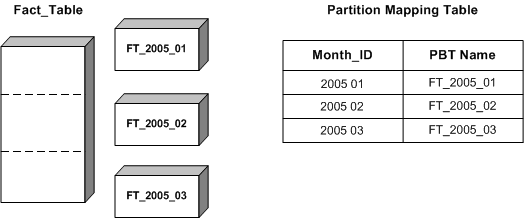MicroStrategy ONE
Warehouse partition mapping
Warehouse partition mapping is the mapping of partitions, where the mapping is performed by and maintained in the data warehouse. You can define a warehouse partition by using the MicroStrategy Warehouse Catalog to add a table with a special structure. This table contains the map for the partition, and is stored in the warehouse. Warehouse partitions divide tables physically along any number of attributes, although this is not visible to the user.
Warehouse partitions must be homogenous, unlike metadata partitions, so that the same amount of data is stored at the same PBT level and the same facts and attributes are defined. Homogenous partitioning divides data of equal levels, like January and February. A sample fact table and warehouse partitioning table are shown below for months. Note how the data exists at equal levels, for example, different months of the same year.

The original fact table, which contains all of the data, is not brought into the project. Rather, the database administrator creates multiple smaller physical tables in the data warehouse. Each table contains a subset of the data in the original fact table. The database administrator is responsible for keeping the partitions consistent and up-to-date. He or she must also create and maintain a partition mapping table (PMT), which is used to identify and keep track of the partitioned base tables as part of a logical whole.
After the PMT is created, when you run a report in Developer or Web that requires information from one of the PBTs, the Query Engine first runs a pre-query to the PMT to determine which PBT to access to bring the data back for the report. The pre-query requests the PBT names associated with the attribute IDs from the filtering criteria. When it finds the name of the PBT, it calls the SQL Engine to write the appropriate SQL for the warehouse.
When using warehouse partition mapping, it is usually not necessary to bring in the individual PBT tables into the project. Doing so can cause errors if such tables are mistakenly mapped directly to schema objects. You should only include the PMT table in the project. With this strategy you can map all related schema objects to the PMT, which then accesses the correct PBT in the warehouse.
-
There are no data slices in a warehouse partition.
-
MicroStrategy supports warehouse partitions on both upgraded and newly created projects. These are added using the Warehouse Catalog Browser. For steps to add warehouse partitions, refer to the MicroStrategy Developer Help (formerly the MicroStrategy Desktop Help).
